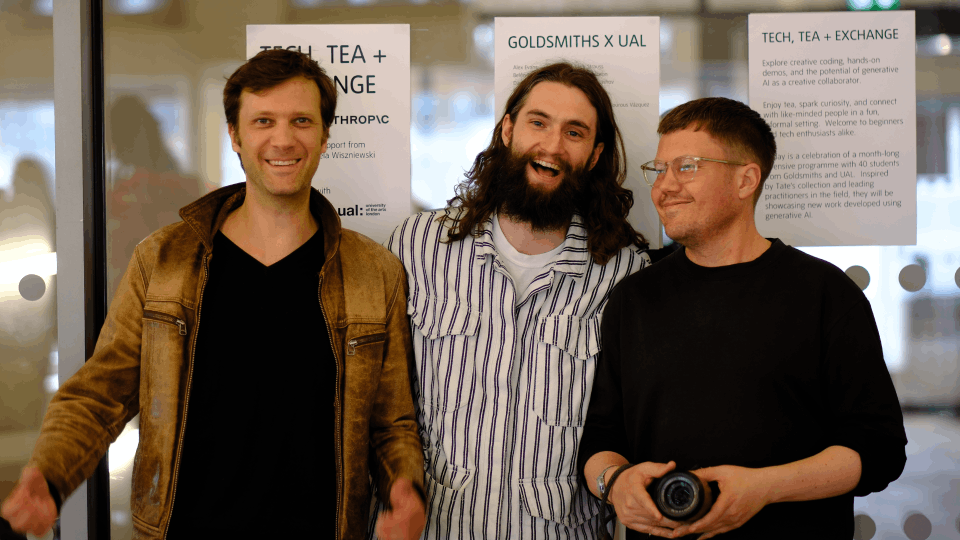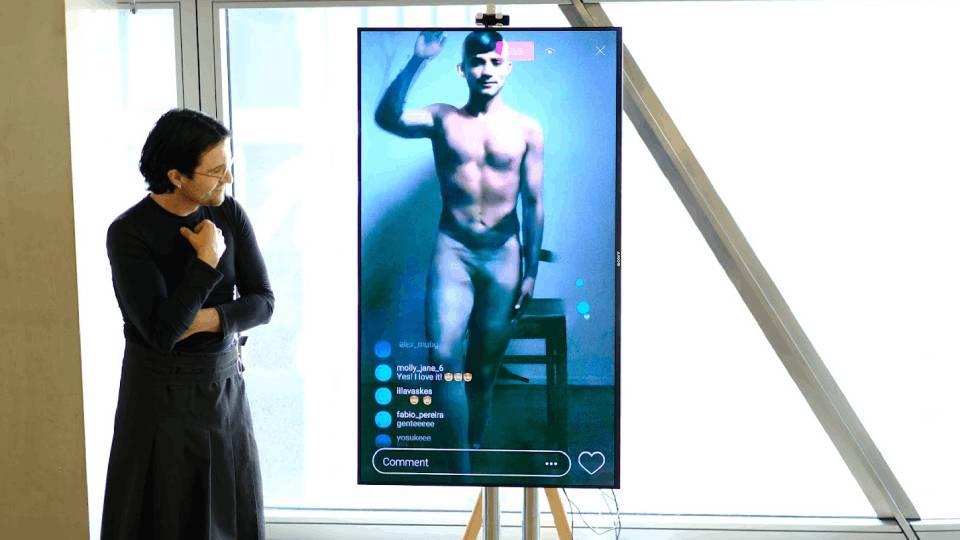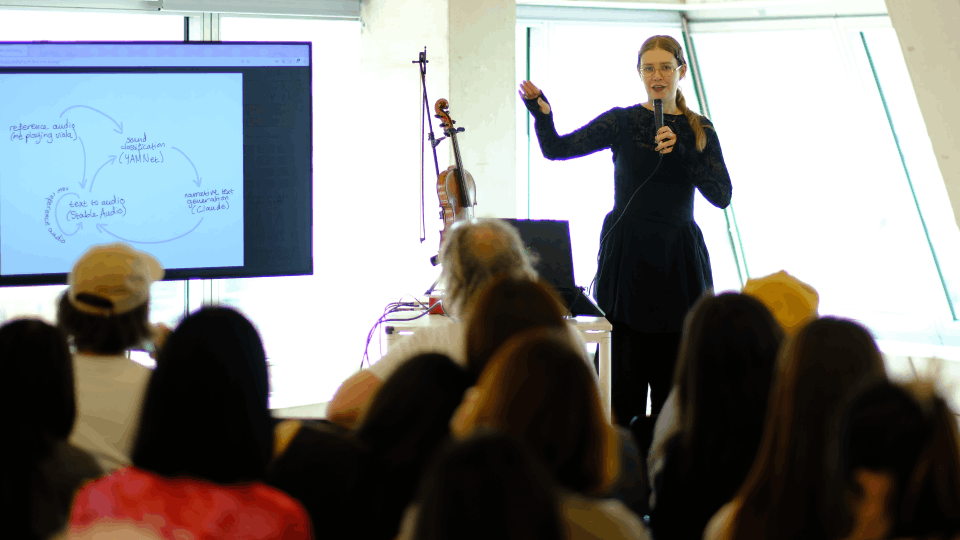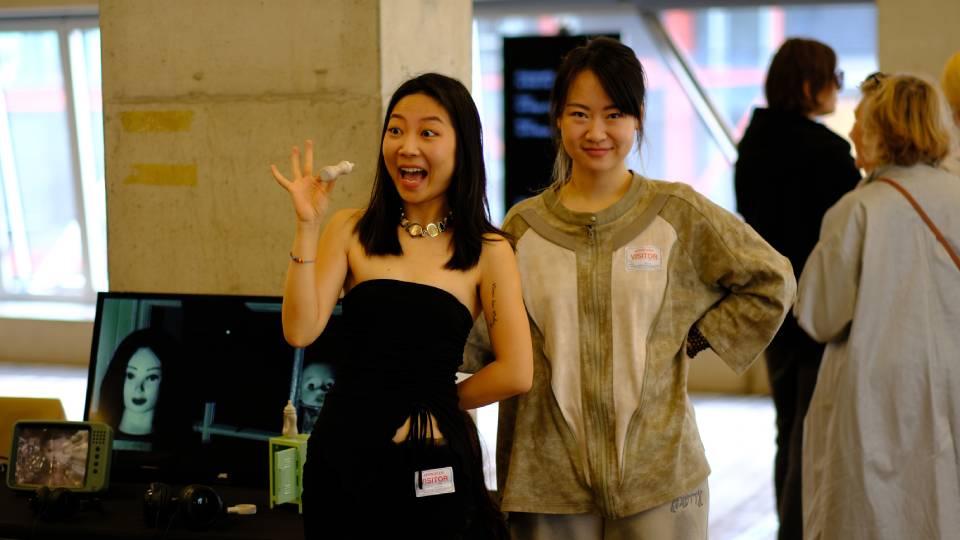Students showcase art generated in collaboration with AI at Tate Modern
Primary page content
Goldsmiths Creative Technology students have been at the heart of a prestigious new digital arts residency, Tech, Tea + Exchange, at Tate Modern.

Digital arts academic staff, Jérémie Wenger, Robin Leverton, Nathan Bayliss at Tate Modern
Goldsmiths Creative Technology students have been at the heart of a prestigious new digital arts residency, Tech, Tea + Exchange, at Tate Modern this summer, collaborating with experts from AI company Anthropic, and curators at Tate as well as peers from University of the Arts London (UAL).
Tech, Tea + Exchange is an integral part of Tate’s Digital Intimacies programme , which explores the generative, emotive, and living relationship between humanity and technologies through a series of live experiences, performances, discussions, hands-on lab sessions, and a special supper club series. Ranging from ancient myths to cutting-edge innovation, the programme is designed to reveal how artists have used technologies to expand our human experience, reimagine new worlds, help us process loss, and find companionship.

Fá Maria - PhD Candidate
The series is inspired by the exhibitions Electric Dreams and Ed Atkins and featured keynote talks by renowned artists in the digital art field Hito Steyerl and Lawrence Lek in conversation with Goldsmiths former Assastant Professor and author of The Black Technical Object, Ramin Amaro.
Over a month-long residency, 40 students worked both in the galleries and behind the scenes at Tate Britain and Tate Modern, reimagining the museum’s collections through experimental responses developed with generative AI.
Their work culminated in a public showcase at Tate Modern, where visitors were able to explore AI-generated artworks, immersive environments, and expanded writing practices. Students were on hand to discuss their creative process and reflect on the evolving relationship between art, humans and machines.
“This project offered students a truly rare opportunity to engage their existing art practice with AI not just as a tool, but as a creative partner.”
Rachel Falconer, Head of Digital Arts
Important conversations about authorship, agency and ethics of AI
Each public event was packed, creating a vibrant atmosphere where curiosity, creativity and critical conversation flowed. Visitors engaged with students as they shared work-in-progress shaped through dialogue with AI tools, sparking rich discussions around authorship, agency and the ethics of machine learning. The events also gave students a rare platform to experiment with their art practice publicly, test ideas in real time, and connect their creative process with live audiences in one of the world’s leading art institutions.
“This project offered students a truly rare opportunity to engage their existing art practice with AI not just as a tool, but as a creative partner,” said Rachel Falconer, Head of Digital Arts at Goldsmiths and academic lead for the programme.
“Working in close dialogue with researchers, coders and curators has allowed our students to reflect critically and creatively on the possibilities—and limitations—of generative AI in art and expanded writing practices. We’re so proud of what they’ve achieved and excited about where this might lead as the university continues to critically explore the connection between art practice and machines.”

PhD Candidate Lucy Strauss
Students took part in panel discussions, collaborative design workshops, and masterclasses with Anthropic staff where ethics and critical framing of AI were collaboratively framed, before creating new works and staging performances inspired by the Tate’s collections.
Societal impact
The residency also featured contributions from Goldsmiths staff, alumni and art practitioners including Jérémie Wenger, Robin Leverton, Nathan Bayliss, and Dr Daniel McQuillan, whose work on the ethics and societal impact of AI helped frame the wider conversations taking place during the project.
“Goldsmiths has a long history of experimentation and boundary-pushing in art,” added Rachel Falconer. “This partnership with Tate and Anthropic continues that tradition, putting our students right at the centre of some of the most exciting—and urgent—questions in contemporary culture and art practice.”

Viola Lang and May Li (MFA Computational Arts)
Building on the momentum of these exchanges, the work developed during the residency will inform a curated exhibition later this year—offering a deeper reflection on the role of generative AI in contemporary creative practice and showcasing the students’ evolving ideas in a new public context.